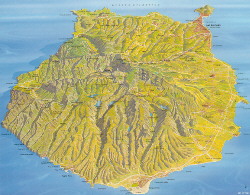


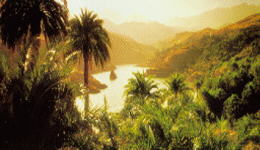
The winds, the sea currents, the relief and its geographical latitude - on the 28th parallel and 60 miles away from the African coast - all this, helps to determine the climate of Gran Canaria, an island of volcanic origin and rich in contrasts. "The Miniature Continent" is the name which most faithfully reflects the wide variety of landscape which the island offers, complemented by a tourist infrastructure of the highest order, making Gran Canaria an ideal place for your leisure and holidays at any time of the year with its continual spring climate.
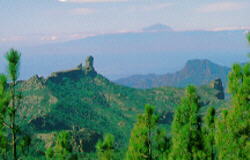
La orografía de Gran Canaria aumenta desde la costa hacia el centro y cumbre, donde se encuentran los puntos más altos: el Pico de las Nieves (1950m) y el Roque Nublo (1813m). La cumbre está rodeada por una serie de cráteres de erosión que forman las cabeceras de los barrancos. Gran Canaria tiene 236 Km de costa, con playas arenosas predominantemente en el Sureste. Aqui podemos encontrar la excepcional Playa del Ingles y las Dunas de Maspalomas. Al Oeste y Suroeste dominan los acantilados, mientras que en el Norte y el Noreste se alternan los dos tipos de costa, ofreciendo una amplia variedad de playas y calas. La Madre Naturaleza ha sido generosa con Gran Canaria, dotándola con los más diversos tipos de paisajes, permitiendo así un turismo muy variado.
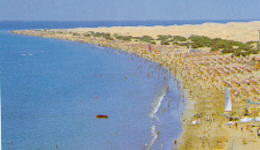
The orography of Gran Canaria increases from the coast towards the centre and the massif of the summit, where the highest points are to be found: the Pico de las Nieves (l.950 m) and the Roque Nublo (l.813 m). The massif of the summit is surrounded by a series of "craters of erosion " which form the heads of the ravines. lts coast is 236 km long, with low shores and sandy beaches predominating in the south east. We find here the excepcional and famous Playa del Inglés and the dunes of Maspalomas. In the west and south-west, cliffs dominate the scenery, while in the north and north-east, the two types of coast alternate, offering an immense variety of beaches and coves. Mother nature has been generous to Gran Canaria, endowing it with the most diverse shades of landscape, thus enabling a wide variety of tourism.
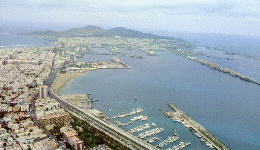
Las Palmas de Gran Canaria, capital de la isla, se encuentra al Norte en un magnífico enclave formado por dos bahías y sus playas- Playa de Las Canteras y Playa de Las Alcaravaneras. Fundada el 23 de Junio de 1478, tiene una importante base histórica y cutural, centrada sobre todo en el distrito histórico y colonial de Vegueta. La ciudad tiene una buena infraestructura de hoteles y apartamentos y excelentes comunicaciones con las otras principales areas populares de la Isla. El puerto de Las Palmas (Puerto de La Luz) es uno de los más importantes de España y le otorga a la ciudad ese carácter cosmopolita que la distingue de las otras ciudades del archipiélago.
Las Palmas de Gran Canaria (in Spanish) , capital of the island, is found in the north in a magnificent enclave formed by two bays and their beaches - Playa de Las Canteras and Playa de Las Alcaravaneras. Founded on June 23, 1478 it has an important historical and cultural base, centred above all in the historical and colonial district of Vegueta. The city has a fine infrastructure of hotels and apartments and excellent communications with the island's other main populated areas. The port of Las Palmas (Puerto de La Luz) is one of the most important in Spain and confers upon the city that cosmopolitan character that distinguishes it from the other cities in the archipiélago.
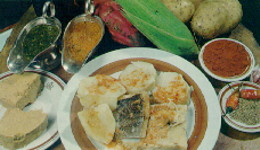
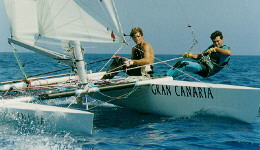
Aparte de sus magníficas playas, el sol constante y sus variados paisajes, Gran Canaria ofrece la posibilidad de practicar cualquier deporte al aire libre durante todo el año: golf, tenis, natación, volleyball y, por supuesto, deportes acuáticos: submarinismo, surf, windsurf; se considera a Gran Canaria como el segundo mejor sitio para la práctica de este último, en la playa de Pozo Izquierdo. Cada año son más las regatas internacionales que eligen nuestros puertos deportivos como punto de partida para sus competiciones, engalanando los muelles con una gama de colores que los hacen más impresionantes. Gozad de una completas vacaciones y practicad vuestro deporte favorito en Gran Canaria.
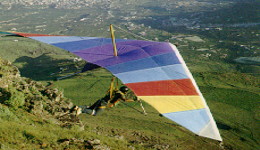
Apart from its magnificent beaches, the constant sun and its varied landscape, Gran Canaria offers the possibility of practising any sport in the open air all year round: golf, tennis, swimming, volleyball and of course water sports; diving, surfing, windsurfing; Gran Canaria is considered to be the second most ideal place in the world for the practice of this latter sport at the Pozo Izquierdo beach. Every year more and more international regattas are choosing our yachting marinas as the departure point for their competitions, festooning the harbours with an array of colours which makes them even more impressive. Enjoy yourselves wiht a complete holiday and practise your favourite sport on Gran Canaria.
Excursión 2 - El Centro: (in Spanish)
Excursión 3 - El Sur: (in Spanish)
 Canarias
Canarias  Página principal del DIS (ULPGC)
Página principal del DIS (ULPGC)